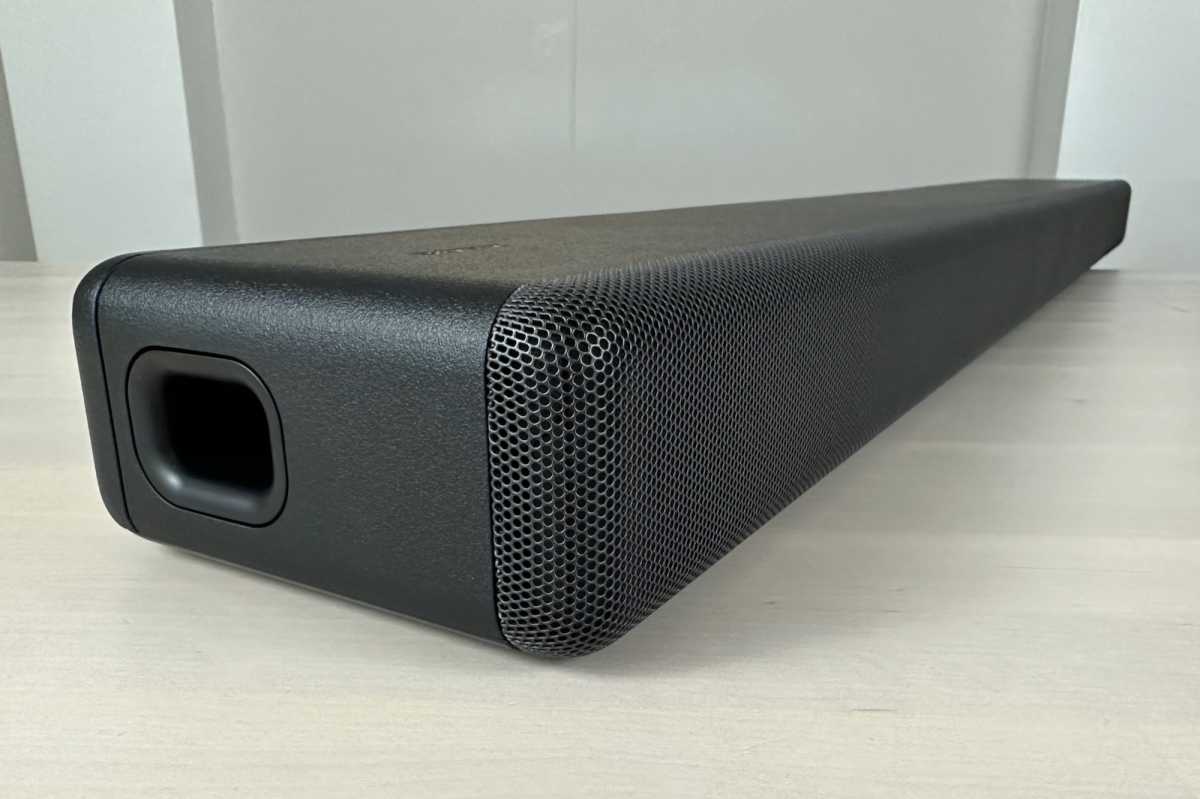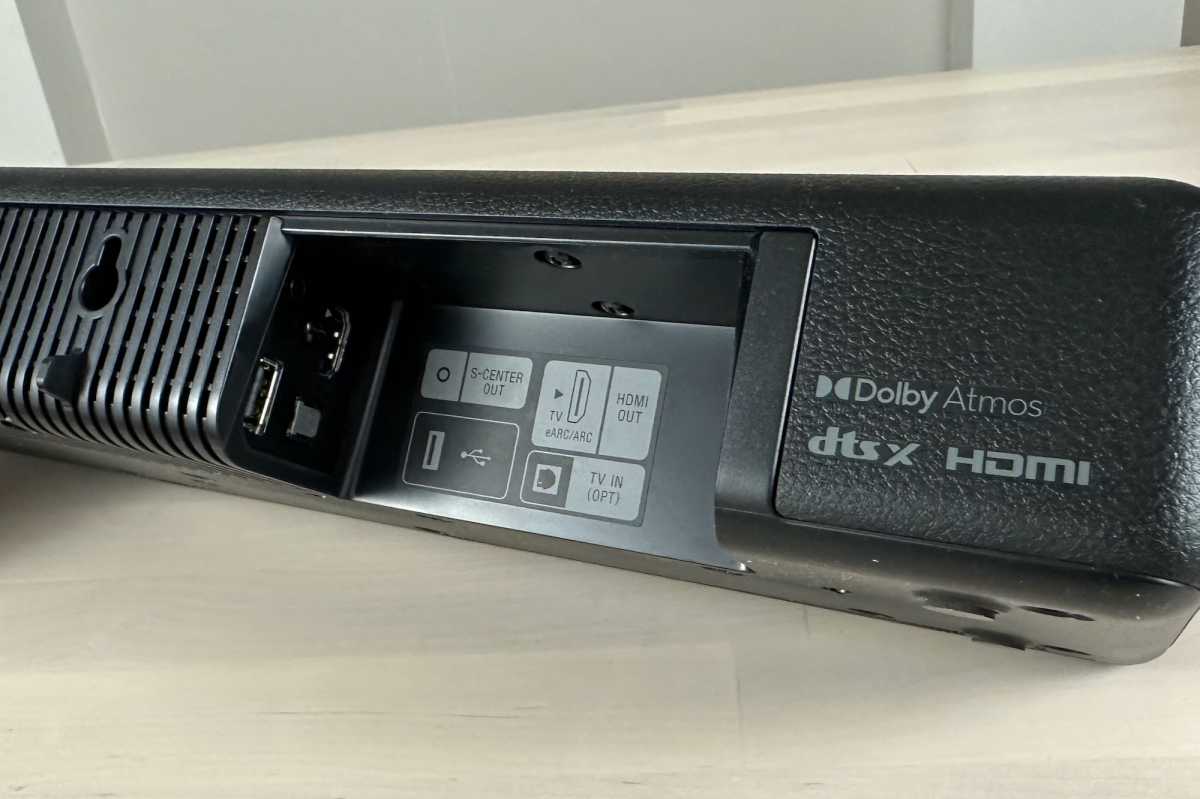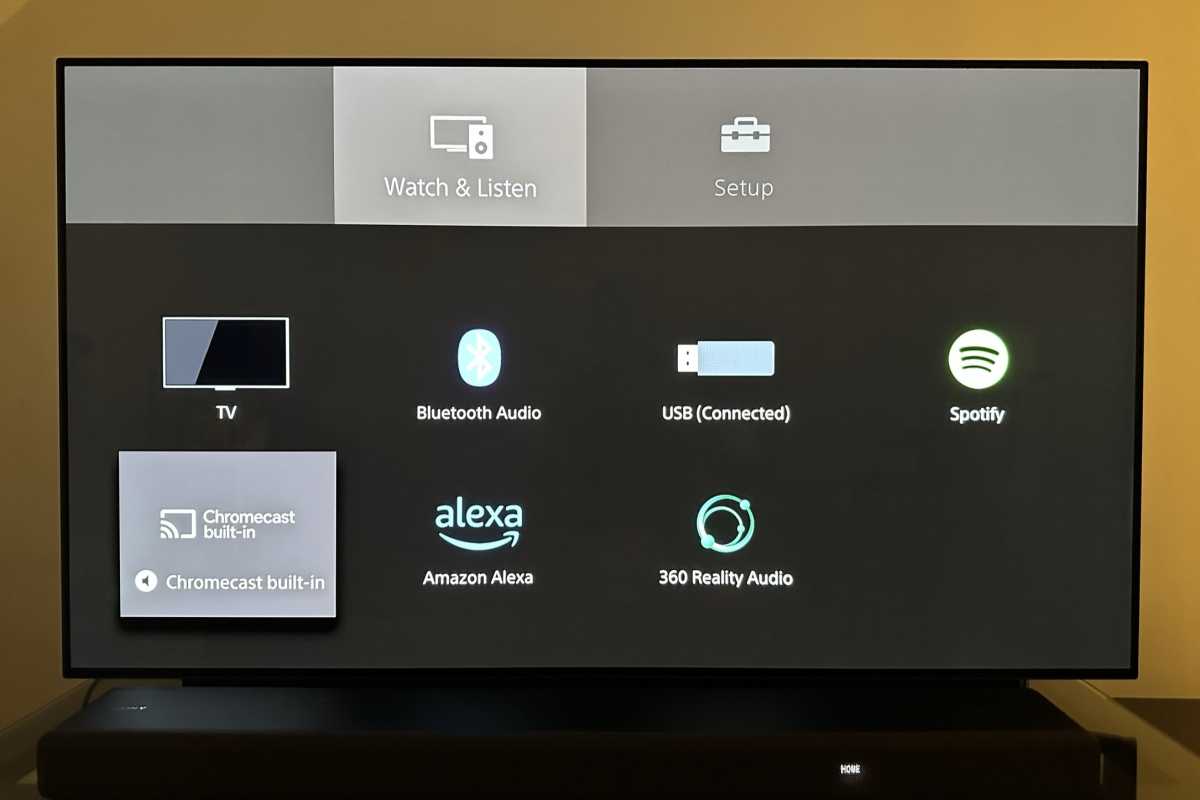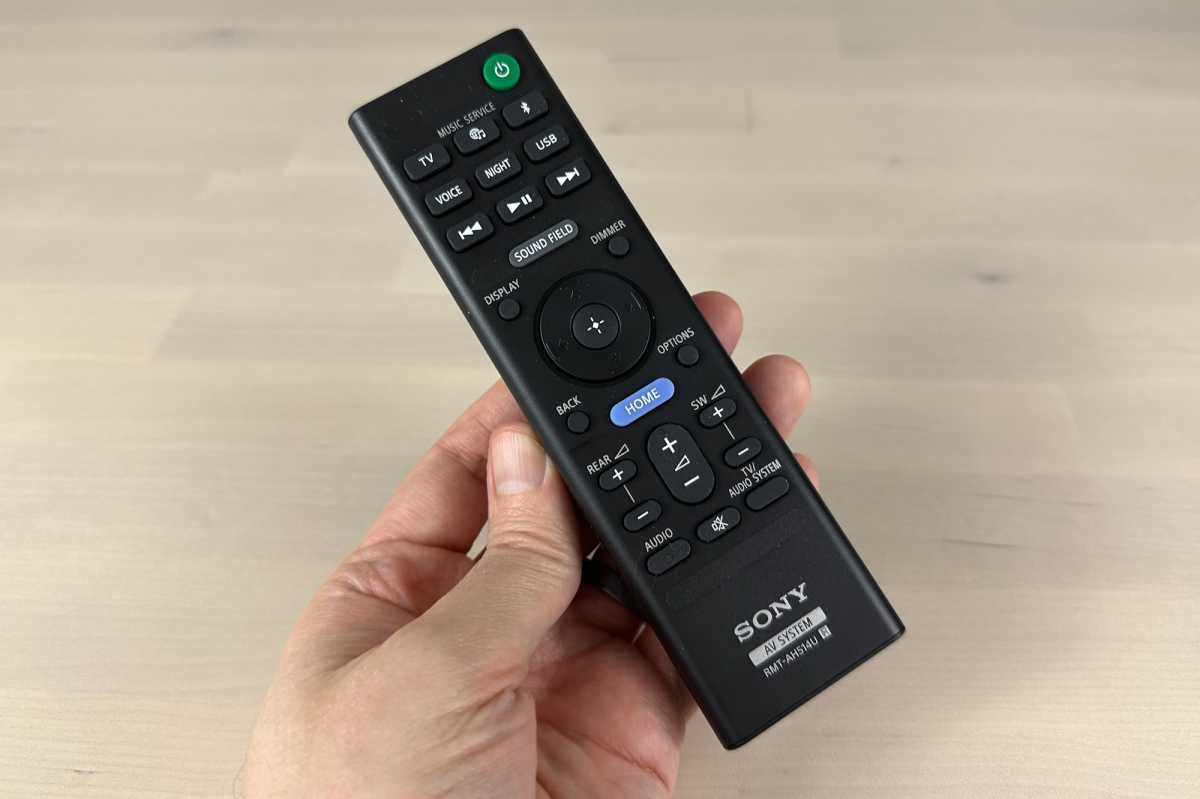Expert’s Rating
Pros
- Rich, full-bodied, and balanced sound
- Supports Dolby Atmos and DTS:X
- AirPlay 2 and Chromecast
- Support for hi-res LDAC codec
Cons
- 360 Spatial Sound requires optional rear speakers
- Rear speaker power cables are too short
- Just one HDMI connector
- Connecting to Wi-Fi took an extra step
Our Verdict
The 3.1-channel Sony HT-A3000 delivers solid Dolby Atmos and DTS:X performance on its own, but it wows when connected to Sony’s optional wireless rear speakers and subwoofers.
Best Prices Today: Sony HT-A3000

$698.00

$699.99
When I think of Sony audio components, I think of solid, detailed, and unfussy sound, and that’s what the HT-A3000 soundbar delivers. On its own, the HT-A3000 cranks out impressive Dolby Atmos and DTS:X sound, albeit for a lofty $699 price tag. But once paired with an optional wireless speaker kit and subwoofer, the HT-A3000 really begins to sing, making it one of my favorite soundbars yet.
My enthusiasm for the Sony HT-A3000 together with the SA-RS3S wireless rear speakers and SA-SW3 subwoofer (all supplied by Sony for this review) stems from the manufacturer’s 360 Spatial Sound technology, which gets unlocked once the soundbar is paired with the rear satellites. With 360 Spatial Sound engaged, the HT-A3000 can project a series of “phantom” speakers in a room, filling it with sound. The results are delightful. Yep, we’re talking a dome of immersive audio, and I thoroughly enjoyed being inside it.
This review is part of TechHive’s in-depth coverage of the best soundbars.
How many channels does the Sony HT-A3000 deliver?
On its own, the HT-A3000 ($699.99) is a 3.1-channel soundbar, with three forward-firing 46- x 93mm cones supplying audio for the left, right, and center channels, while two forward-firing woofers (45- x 108mm) serve up the low-frequency effects.
The Sony HT-A3000 plus optional wireless rear speakers and a subwoofer costs a lot of cash, but there’s a lot of sonic excellence, too.
To upgrade the HT-A3000, you can add Sony’s SA-RS3S wireless rear speaker kit ($350). Each of the two rear speakers (which are reassuringly heavy at roughly 2.5 pounds a piece) comes equipped with a 46- x 54mm woofer and a 16mm tweeter, along with a bass reflex port. We evaluated the SA-R35S for this review, but Sony also offers the battery-powered SA-RS5 rear speaker kit for $600.

The Sony HT-A3000 has bass reflex ports on either side.
Ben Patterson/Foundry
To bolster the bass, you can add one of Sony’s two wireless subwoofers. We received the 200-watt SA-SW3 with a 160mm woofer for review ($400), or you could opt for the more powerful, 300W SA-SW5 subwoofer ($700).
Put all those components together, and the HT-A3000 becomes a full-on 5.1-channel system, albeit for a total–and somewhat lofty–$1,450 price tag.
Sony also offers the HT-A5000, a 5.1.2-channel soundbar with two upfiring drivers for $999.99 (read our Sony HT-A5000 review), while the $1,399.99 HT-A7000 delivers 7.1.2 channels of audio.
Does the Sony HT-A3000 come equipped with upfiring drivers?
The HT-A3000 lacks the upfiring drivers that many competing soundbars (including the pricier HT-A5000 and HT-A7000 models) use to bounce Dolby Atmos and DTS:X height effects off the ceiling. Instead, it uses Sony’s Vertical Surround Engine technology to simulate (quite effectively, as I’ll describe shortly) height effects, while the manufacturer’s S-Force Pro Front Surround tech uses virtualization to widen the front soundstage.
Finally, Sony employs 360 Spatial Sound Mapping, its latest 3D audio feature, to place a series of “phantom” speakers around the room. We’ve tried 360 Spatial Sound on other Sony systems and came away thoroughly impressed, but we’ll save our thoughts about how the technology works on the HT-A3000 for later in the review. Just keep in mind that if you want to enjoy 360 Spatial Sound on the HT-A3000, you’ll need to connect one of Sony’s two wireless rear surround kits to the soundbar.
How many HDMI inputs does the HT-A3000 have?
The Sony HT-A3000’s various inputs and outputs are contained in a rear cavity on the right-hand side of the soundbar. Tucked inside the cavity, you’ll find a single HDMI-eARC connector, an optical (Toslink) input for legacy TVs, a USB-A port, and what Sony calls an “S-Center” output.
The HDMI-eARC connector will let you send audio down to the soundbar from your TV’s HDMI-ARC connector; if your TV has a matching HDMI-eARC interface (for “enhanced” ARC), your set will be able to pass lossless Dolby TrueHD and DTS-HD Master Audio signals to the soundbar. That’s handy if you have a Blu-ray player or a Blu-ray-equipped game console connected to one of your TV’s HDMI inputs. As the HT-A3000 doesn’t have a separate HDMI input, you won’t be able to connect a second video source directly to the soundbar.
The optical connector will be a boon for those with older TV sets that lack HDMI, or if you have an audio playback device that only has an optical output.

The Sony HT-A3000 has a single HDMI-eARC port, an optical (Toslink) input, and a USB-A port capable of reading media files.
Ben Patterson/Foundry
Can the Sony HT-A3000’s USB port access audio files?
Then we have the USB port, which is capable of accessing audio files on an external USB drive. The HT-A3000 can decode a wide range of audio files, from MP3 and WMA to FLAC and Ogg Vorbis. I transferred a 24-bit/192kHz FLAC file to a USB flash drive, plugged it into the HT-A3000’s USB port, and the soundbar played the FLAC file without any trouble.
Finally, there’s that “S-Center” output, which allows the owners of Sony Bravia TVs to use their TV speakers as a center channel. If your Bravia set supports the feature, you’ll see an S-Center input on the back of the TV, and a cable included in the HT-A3000 box will let you make the necessary connection. Since I have an LG C9 OLED TV rather than a Sony Bravia, I was unable to test the feature.
Can the HT-A3000 be mounted on a wall?
As with most other soundbars, physical setup for the Sony HT-A3000 is easy. You can either place the soundbar in front of your TV or mount it on the wall beneath your TV (Sony provides a wall mount template, but no actual mounting screws or brackets). You then connect the HT-A3000 to a wall outlet with the included power cord, connect the soundbar to your TV with the included HDMI cable, and power on the unit with the remote.
If you opted for the SA-RS3S wireless rear speaker kit and the SA-SW3 subwoofer, there are a few more steps. The SA-RS3S satellites go behind your sofa, and they come with six-foot power cables that might be restrictive depending on where the available wall outlets are in your home theater. I’ve complained about short power cords for wireless rear speakers from other manufacturers, but I eventually broke down and bought extension cords.
Similar to the wireless rear speakers, the SA-SW3 sub comes with a five-foot power cable. Theoretically, the subwoofer can be placed anywhere in the room, but you’ll need to do a little experimenting to get the best sound out of the speaker; placed in the wrong position, the SA-SW3 might sound too boomy. Doing the “subwoofer crawl”–that is, carefully moving the sub from one position to another and doing some listening tests–can help wring the ideal amount of bass from the speaker.
With the components in place and powered up, you can then connect the HT-A3000 to the other speakers either automatically or manually; an on-screen menu guides you through the process. I had to use the manual version, likely because the review units I received from Sony had been previously used by other journalists. In any event, the manual pairing process was easy; I just pressed and held the designated rear buttons on the wireless satellites and subwoofer to put them in pairing mode, and the soundbar found them within a few seconds.
Does the HT-A3000 connect to Wi-Fi?
Next, you’ll need to connect the HT-A3000 to your home Wi-Fi router. If you’re an iOS user, your iPhone should be able to detect the soundbar as an AirPlay speaker in your Wi-Fi settings, and you’ll then be able to connect the soundbar in just a few taps. In my case, my iPhone didn’t recognize the HT-A3000 as an AirPlay speaker, so instead I went through the typical manual process of picking my router’s SSID from a list and keying in my password with the remote–a tedious process, but I only needed to do it once.
There’s one more step for those who’ve invested in Sony wireless rear speakers to go with the HT-A3000: calibrating the soundbar’s 360 Spatial Sound. You’ll either be prompted to do this from the on-screen “easy setup” wizard, or you can initiate the calibration process later, via the advanced setup menu. Either way, the 360 Spatial Sound calibration takes just a few minutes, and it consists of a series of buzzes and beeps coming from each speaker.
Does the HT-A3000 have an on-screen interface?
The HT-A3000 has an on-screen “Home” interface that lets you access a variety of functions, some of which are more useful than others.
Besides a Setup menu, you can click the “TV” icon, although that screen just directs you to adjust the TV input using your TV’s own remote. The Bluetooth Audio options puts the soundbar into pairing mode, while the Chromecast, Amazon Alexa, Spotify, and 360 Spatial Sound icons only give you information about (and in the case of 360 Spatial Sound, a demo of) those features.

The Sony HT-A3000’s on-screen menu lets you access the soundbar’s advanced settings, as well as other features.
Ben Patterson/Foundry
While the Home screen can be clunky to use, you can access most of the Home functions from the cluttered HT-A3000 remote. From the top of the remote, you can quickly switch to TV audio by tapping the “TV” button, as well as enter Bluetooth pairing mode, switch to Spotify, jump to the USB input, or activate either the Voice or Night modes (the former boosts dialogue audio, while the latter muffles loud noises during after-hours listening sessions).
Further down, a Sound Field button lets you toggle the HT-A3000’s various sound enhancements, such as 360 Spatial Sound and the Vertical Sound Engine (I deactivated the sound modes once, heard the flat, narrow audio, and immediately turned the modes back on again), while more buttons near the bottom of the remote let you trim the rear and subwoofer volume levels. I particularly appreciated the Dimmer button, which lets you adjust the brightness of the soundbar’s front LED display, or turn it off altogether following a brief period of inactivity.
Then there’s the Sony Music Center app, which lets you access most of the same features as you can from the remote. The app also lets you tap into media servers on your home network (such as a Plex media server or a NAS), as well as import playlists from various music services; for example, I was able to access my Apple Music playlists from the app.

The HT-A3000’s remote features a Home button that calls up an on-screen interface.
Ben Patterson/Foundry
Does the Sony HT-A3000 support Apple AirPlay 2 and Google Chromecast?
The HT-A3000 supports both Apple AirPlay 2 and Google Chromecast, allowing you to stream audio to the soundbar via an iPhone or an Android phone. You’ll also be able to include the HT-A3000 in multi-room AirPlay 2 and Chromecast setups.
Moving along, the soundbar boasts Spotify Connect, which means you can select it as an audio playback device from the Spotify app, while you’ll be able to play 360 Spatial Sound-mixed tracks from Amazon Music, Tidal, and the live-concert-streaming service Nugs.net.
Finally, the HT-A3000 offers Bluetooth 5.0 support, complete with the default SBC codec, AAC (ideal for iPhone users), and LDAC, Sony’s high-resolution Bluetooth codec. The soundbar will also transmit Bluetooth, including using the LDAC codec, to a pair of Bluetooth headphones, including Sony’s best-in-class WH-1000XM5 headphone.
As far as smart home support goes, the HT-A3000 works with both Alexa and Google Home, and it can be controlled with voice commands (“Alexa, turn down the volume on the soundbar”) when spoken to a nearby smart speaker. The soundbar lacks a built-in voice assistant, however.
How does the HT-A3000 sound?
I’m focusing my evaluation of the Sony HT-A3000 on its performance when paired with Sony’s SA-SW3 wireless rear speaker kit and SA-SW3 subwoofer, a combination that (as I mentioned earlier) adds up to a not-inconsiderable $1,450 price tag. That’s a lot of cash, but luckily there’s a lot of sonic excellence here, too.
I began my listening tests with the UHD Blu-ray of Star Wars: The Empire Strikes Back, which has a remastered Dolby Atmos soundtrack. Zipping over to the Battle of Hoth chapter, I was quickly impressed not only by how three-dimensional the scene sounded–laser blasts, crunching Imperial Walker stomps, and whizzing Rebel snowspeeders seemed to be coming from everywhere–but also by how well balanced the audio felt.
For instance, John Williams’s muscular score sounded clear and clean, the clunking Imperial Walkers felt deep but satisfyingly tight (I nudged the subwoofer volume level down a step or two to fix some initial boominess), and the surround and height effects sounded surprisingly natural. Indeed, Sony’s 360 Spatial Sound-enhanced height cues never exhibited the harsh, artificial audio artifacts I’ve heard from other soundbars that virtualize their height channels.
For Empire, I also briefly disconnected the rear speakers and subwoofer to hear how the HT-A3000 sounded on its own. The answer: Not bad! The audio was certainly less immersive (remember, 360 Spatial Sound only works when Sony’s rear speakers are connected, although the Vertical Surround Engine and S-Force Pro Front Surround still work), but I still got a sense of ambient surround action and even some decent height effects, not to mention solid bass from the built-in woofers. The HT-A3000 sounds undeniably better when paired with surround speakers and a subwoofer, but if you’d rather start with the soundbar itself and upgrade later, you won’t be too unhappy.
Next, I strapped in for the UHD Blu-ray of Apollo 13, which has a DTS:X soundtrack. Jumping directly into the launch sequence, the HT-A3000 and its accompanying speakers did an unsurprisingly good job of delivering the thunderous roar of the Saturn V’s engines as well as the clanks of the massive clamps as they detached from the slowly rising rocket. But again, I was struck by the balance of the sound: detailed without being shrill, deep but not overpoweringly bassy, immersive yet not distractingly so. Classic Sony.
Leaving the discs behind, I fired up my Apple TV 4K and dialed up 1978’s Superman in Dolby Vision and Dolby Atmos. I’m a big fan of the dynamic title sequence, with John Williams’s famous Superman theme and the credits that swoop up, down, and away. The HT-A3000 didn’t disappoint, ably delivering the swooshes of the soaring credits, complete with surround and height effects, as well as the crisp, clean score from Williams.
Moving on to music, I queued up Ravel’s complete solo piano works performed by Betrand Chamayou for the Erato music label. The album is presented in Dolby Atmos on Apple Music, and played on the HT-A3000 via Apple TV, Chamayou’s performance sounded clear and distinct, revealing the timbre of the keystrokes without collapsing into a jumble. Likewise, the soundbar served up lively, vibrant renditions of “Lavender Haze” and “Maroon” on Taylor Swift’s Midnights, while Billie Eilish’s “Oxytocin” on Happier Than Ever sounded natural and well balanced, with no need to tweak the subwoofer levels to accommodate the track’s deep bass line.
Is the Sony HT-A3000 worth the cash?
Even when used on its own, the Sony HT-A3000 makes for a worthy all-in-one Dolby Atmos and DTS:X soundbar. But the HT-A3000 reaches its true potential when matched with Sony’s wireless speaker kit and soundbar, which allows for the full 360 Spatial Sound experience.
Yes, it’s an expensive package, but the supple, immersive, well-balanced sound is worth the price of admission, not to mention the AirPlay 2 and Chromecast support and Sony’s high-resolution LDAC Bluetooth codec (provided you have headphones that can take advantage of it).
Of course, some may rather pay more for a soundbar system that has actual up-firing speakers, and for them I’d recommend the step-up Sony HT-A5000, our reigning champ among high-end soundbar and wireless speaker packages.




